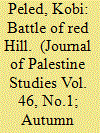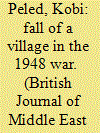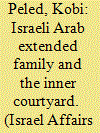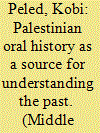| Srl | Item |
| 1 |
ID:
148603


|
|
|
|
|
| Summary/Abstract |
This article explores the relations between inhabitants of the Upper Galilee village of Mi'ilya and soldiers of the Arab Salvation Army (ASA) in the months leading up to the conquest of the village in October 1948. Using interviews conducted in Arabic with surviving elders from Mi'ilya as well as contemporaneous Hebrew documents preserved in the archives of the Israeli army, the article aims to construct an integrated historical narrative of events. Throwing light on little-known figures of the ASA, the study uncovers the complex web of relationships that emerged in the day-to-day interactions of the ASA volunteers with the Palestinian villagers they were sent to defend. Particular emphasis is placed on the battle of Red Hill, now mostly forgotten, which took place almost three weeks before the fall of the village, mobilizing ASA troops, members of the local militia, and residents of Mi'liya in a joint effort to fend off encroaching Israeli forces.
|
|
|
|
|
|
|
|
|
|
|
|
|
|
|
|
| 2 |
ID:
160042


|
|
|
|
|
| Summary/Abstract |
The present paper attempts to take a close look at the events surrounding the conquest of the Palestinian village of Mi’ilya in the 1948 war based on Hebrew-language documents in the Israel Defense Forces archive and interviews conducted in Arabic with elderly people living in Mi’ilya. Its aim is to explore how these two types of sources and the distinct cultures of remembrance which they represent may be combined to produce a new historical canvas, affording a broader and deeper picture than could be achieved based on the Israeli archive alone or on Palestinian memories alone. Our main concern has been to reconstruct the past, a task that has become particularly urgent as regards oral memories of the war. At the same time we seek to show how present-day cares weigh on our recollections of the past and affect their form.
|
|
|
|
|
|
|
|
|
|
|
|
|
|
|
|
| 3 |
ID:
118382


|
|
|
|
|
| Publication |
2013.
|
| Summary/Abstract |
This article presents significant transformations in the social history of the Israeli Arab extended family as reflected in the architectural history of the inner courtyard - once the focal point of the extended family's economic and social life. The article places this socio-architectural perspective within its broad political, economic and demographic contexts. As an interdisciplinary study in the sociology of space, it weaves together anthropological insights regarding social structures and processes and geographical explanations of the rapid changes in the landscape of Israeli Arab villages, towns, and cities.
|
|
|
|
|
|
|
|
|
|
|
|
|
|
|
|
| 4 |
ID:
130740


|
|
|
|
|
| Publication |
2014.
|
| Summary/Abstract |
The purpose of this article is to further explore the potential for Palestinian oral history to be used as a source for understanding the past. It examines existing directions in this field and highlights new approaches based on a discussion of an oral history project conducted by the author of this paper - a Jewish Israeli - in the Upper Galilee between the years 2006 and 2011. The article sharply illustrates the necessity and the urgency of recording Palestinian oral history with regard to the period that preceded the 1948 war, especially where written sources are lacking. It demonstrates the richness of oral history among Palestinians in Israel and exemplifies its ability to capture a vivid picture of a segment of Palestinian rural life before the Nakba. Methodologically, the article emphasizes the significance of cross-checking non-dependent oral sources as well as cross-checking oral sources against written testimonies as a means of striving for the truth and as a useful way of examining the reliability of oral sources.
|
|
|
|
|
|
|
|
|
|
|
|
|
|
|
|
| 5 |
ID:
133532


|
|
|
|
|
| Publication |
2014.
|
| Summary/Abstract |
Water sources have always played a significant role in Palestinian rural life. Springs and wells are frequently depicted in orientalist sources, yet they have barely been studied from the perspective of oral history. This article explores the social texture of an ancient well, located in the Palestinian Arab town of Baqa al-Gharbiyya in Israel, by using fragmented memories of the old women and men who drew water from that well more than half a century ago. This study examines the well as a powerful reservoir of local memories, focusing on the feminine experience that was formed at the well, on its symbolic meaning in the lives of Palestinian women, and on a silent language of implicit expressions that was once used at the well.
|
|
|
|
|
|
|
|
|
|
|
|
|
|
|
|
| 6 |
ID:
151853


|
|
|
|
|
| Summary/Abstract |
This article addresses the complex identity of Israel's Palestinian Arab citizens from an atypical perspective: through manifestations of their material culture. The cultural expressions that will be examined are objects from the past and objects that relate to the past, particularly to the rustic Palestinian life profoundly destabilized by the 1948 Arab–Israeli war. These objects, displayed in the homes of some of Israel's Arab citizens, are interpreted by contemplating their design, the design of their environment, their relationship to other objects, and their placement within the domestic sphere. Our study is animated by the desire to sketch a cultural portrait of Palestinian Arab Israelis, as well as by a methodological interest in interpretations based on a socio-architectural reading of objects.
|
|
|
|
|
|
|
|
|
|
|
|
|
|
|
|